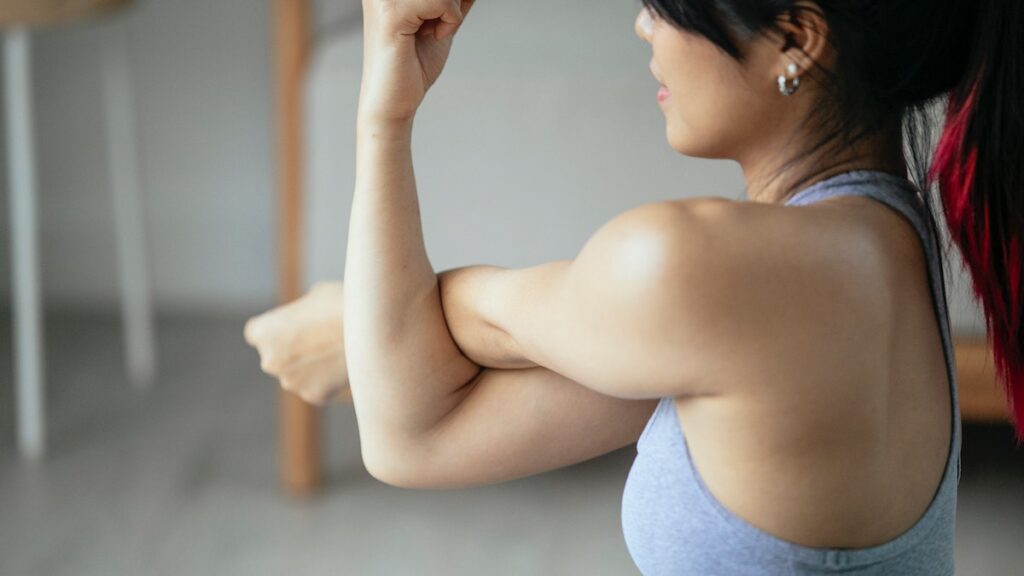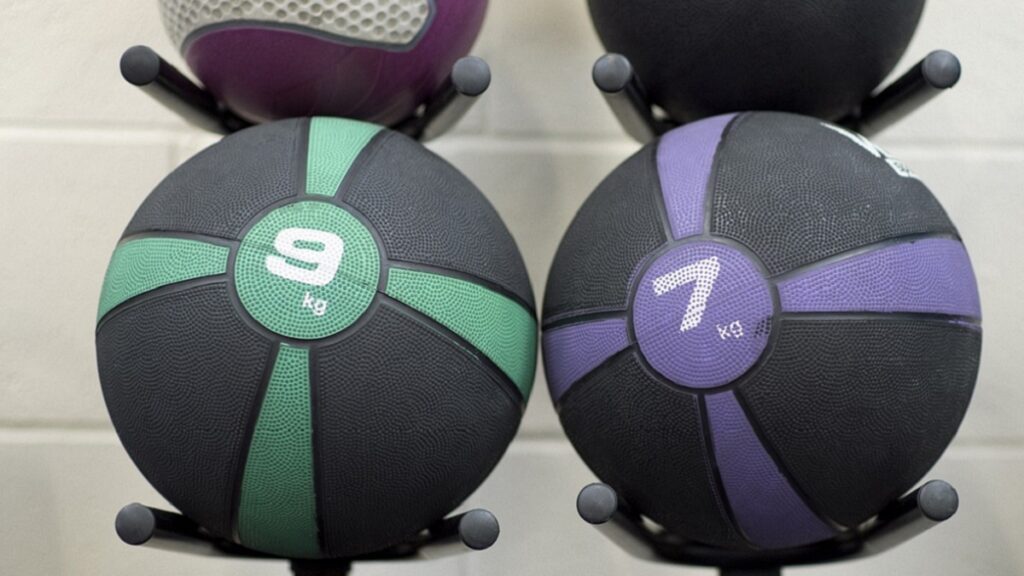A shoulder workout is one of the significant weight room activities, and there are many options you can choose from. Among them are Dumbbell Lateral Raises and Shoulder Presses exercises. Although their goal is ensuring shoulder fitness, they differ in some aspects. Let’s take a closer look at these two workouts: Lateral raise vs. shoulder press:
The main difference between Lateral Raise and Shoulder Press is the shoulders’ section they work on. The former primarily aims at the medial deltoids ( side shoulder muscles), while the latter deals with the anterior deltoids (front shoulder muscles) and the triceps and upper chest muscles partly.
This review provides a profound look into the two exercises to help you decide which is better and when. We focus on their differences, benefits, workout process, and more.
Lateral Raise Vs. Shoulder Press: What Is the Difference?
The shoulder workout focus area is the key difference between Lateral Raise and Shoulder Press exercises. Lateral Raise mainly targets the muscles on the side of your shoulders, while Shoulder Presses work the whole shoulder and extend to other muscle groups like the triceps and upper chest muscles. However, its primary focus is the muscles at the front of the shoulders.
Hence, Lateral Raise is the better option if you’re seeking to isolate the medial delt. Shoulder presses work best for your overall shoulder development.
Also, Shoulder Presses are better strength builders than Lateral Raises. How? They’re a compound workout involving more muscle groups, and their movement’s pressing action stays closer to the body’s midline. Conversely, Lateral Raises rely on the medial delts to lift the dumbbells. The exercise takes the dumbbell away from the midline, a much weaker position.
As a result, Shoulder Presses allow you to use more weight, making them ideal strength developers.
Even so, both exercises ensure your shoulders’ strength, mass, and power. Let’s dive deeper into our two focus shoulder workout plans to understand the Lateral Raise Vs. Shoulder Press better.
Dumbbell Lateral Raises
Lateral Raise is a shoulder isolation exercise that works your deltoids. Your shoulders have the front, middle, and back deltoids that make up their three ‘heads’ where Lateral Raises target the middle delts. Although the workout is easier than the Shoulder Press, you need a proper structure to prevent injuries and obtain maximum benefits.
Moreover, the exercise builds larger deltoids, resulting in a boulder-shoulder look. Using a mix of low and high reps is one way of maximizing your shoulders’ development.
You can have your arms straight or bent when performing Lateral Raises, depending on the weight you use. The arms straight approach requires lower weights with high reps, while the arm bent one needs heavier weight with low reps through a short motion range.
Which Are the Lateral Raiser Worked Muscles?
Delts and traps are the Lateral worked muscles, but medial deltoids are the exercise’s primary focus. Below are the various muscles that the workout impacts:
- Deltoid (Medial, Posterior, and Anterior heads)
- Trapezius (when dumbbells are lifted slightly above the shoulders top)
- Supraspinatus
How Do You Perform Your Lateral Raise Workout?
You perform your Lateral Raise Workout by following simple, actionable steps. Consequently, you isolate the middle deltoid effectively for faster muscle gains. Here’s how:
Step 1: Stand Straight
Stand straight or use a hip hinge to shift the hips back. Hold the dumbbells firmly in a neutral position with your arms bent enough to ensure the elbow joints aren’t fully locked out. Also, drift your arms forward slightly instead of trucking them. Provide preliminary stability by bracing your trunk, core, and legs.
Tip: A torso’s slight inclination extends the shoulders’ motion range during the Lateral Raise performance.
Step 2: Lift the Dumbbells
Position your palms facing your body, holding the dumbbells neutrally. Raise them in semicircular motion to a point slightly above your clavicles. Also, ensure that the heads of the dumbbells are facing down, with your arms roughly parallel to the ground.
Tip: Keep your shoulders depressed when lifting the dumbbells. Shrugging during the exercise can result in the traps taking over too much.
Step 3: Reset and Repeat
Pause slightly in the raised position to create an additional stability demand and increase movement challenge. Then, lower the dumbbells to the starting point under control to prevent position loss or inter-reps additional momentum. Moreover, maintain a straight arm posture with slightly bent elbows and repeat as required. Exhale and inhale up and down, respectively.
Tip: Tension on the deltoid dramatically decreases as you lower the dumbbells to the starting point. Therefore, you may have to stop before getting to your starting position. That ensures the middle delt is loaded throughout the exercise.
What Are the Benefits of the Lateral Raise?
The lateral Raise exercise has several benefits besides its physical impact (muscle hypertrophy). Below are the ups of this workout:
- Muscle hypertrophy
- Proper bracing and stability
- Improved shoulder health
- Targeted muscle growth
Let’s see how the workout contributes to each of the above benefits. Keep reading.
1. Muscle Hypertrophy
The most pronounced benefit accrued to Lateral Raise is muscle hypertrophy: The ability to work the shoulders’ middle aspect. The exercise is one of few that directly targets the shoulder’s part, most critical for the iconic V-tapered look creation. That’s contrary to the many exercises that focus on the front and rear deltoid growth complement.
2. Proper Stability and Bracing
Properly fit shoulders performance is painless and stable in all ranges of motion. The exercise challenges the shoulders’ stability, mainly in the rotator cuff, and as a result, provides a functional stimulus.
3. Improved Shoulder Health
A precise posture and bracing are Lateral Raise requirements to ensure adequate training for the middle deltoid. The posterior chain and trunk bracing engagement in the Lateral Raise can reinforce bracing and stabilization in other exercises (muscle-building and barbell).
4. Targeted Muscle Development
Specific muscle isolation is essential in developing an impressive body. Since the shoulders have three different small regions, you must constantly adhere to the proper approach to identify the targeted muscle section.
Thus, muscular engagement, strict positional awareness, and momentum elimination make or break a Lateral Raise workout.
Who Is Lateral Raise Best For?
Lateral raise is best for those seeking good shoulder strengthening and lateral head muscle development maximization. They include the following categories of people:
- Physique athlete
- Other athletes
- Beginner gym goers
Read on as we expound on each of the Lateral Raise beneficiaries.
1. Physique Athletes
Professional bodybuilders and physique enthusiasts aim to pack as much muscle as possible. A poorly developed middle deltoid leaves a noticeable gap in the shoulder aesthetics if not accorded direct attention.
Fortunately, properly performed Lateral Raises with various implements are effective and safe for a ton of muscle slapping to the middle deltoid that’s otherwise neglected.
2. Other Athletes
Sportspeople like Olympic lifters need proper functionality and stability from their whole shoulder complex. Thus, they spend a lot of time on high-intensity shoulder exercises. Such athletes can use Lateral Raise, a low-impact option to maintain or gain muscle. It’s helpful during their overhead workout with less fatigue.
3. Beginner Gym-Goers
Starter gym-goers may need to improve various fitness areas instantly, and starting their shoulder exercise with overhead pressing might be complex or rough.
Light Lateral Raise can boost muscle development in preparation for more complex shoulder workouts.
Dumbbell Shoulder Press
The Shoulder Press workout is a significant movement for upper body strength. The weights allow your shoulders to move naturally and engage the stabilizing musculature to maintain a healthy status of your shoulders.
Also, you can do your Shoulder Presses while sitting or standing, but they require more stability and better technique due to their free movement. As a result, the exercise is considered more tedious but closely related to sporting and daily exercises: Occurring in a freely moving environment. Hence, it’s an ideal option to progress from a machine shoulder press.
The shoulder workout technique offers an increased range of motion. Thus, you can twist your wrist to the bottom position to get maximum motion range to obtain a longer length to train your muscles.
How Do You Perform Your Shoulder Press Workout?
You can perform your Shoulder Press Workout while sitting or standing. Let me discuss more on this.
Sitting Shoulder Press
Below are the steps to perform Shoulder Press in a sitting position.
Step 1: Get into Proper Position
Get your dumbbells and a stationary bench and set yourself at a proper starting position. Push your feet into the ground after taking your seat. Bring your weights to a starting position, slightly outside your shoulders, and the palms facing outward (with a pronated grip).
Tip: Always have the same setup so that you work towards perfecting your capability.
Step 2: Lift the Weight
Brace your core and depress your scapula, and press the weight overhead. You should lift the weight high above your head: The dumbbells directly above your wrists, the wrists above your elbows, and the elbows above your shoulders.
Tip: Avoid excessive leaning back on the bench. That can prevent maximum deltoid recruitment and compress chest muscles.
Step 3: Control Comedown
Bend your elbows, reverse the pressing movement, and bring down the dumbbells to the starting point under control. Be sure to do so to complete a full rep. Also, repeat the cycle to achieve the required sets and reps.
- Hypertrophy: 4-5 sets of 8-12 reps.
- Beginners: 3 sets of 8-10 reps.
- Strength: 4 sets of 6-8 reps.
Tip: Increase the tension time by slowing down and controlling the eccentric while doing the shoulder press.
Standing Shoulder Press
Follow the simple steps below to perform your Shoulder Press standing.
- Step 1: Set up for the exercise by getting a pair of dumbbells next to you.
- Step 2: Stand straight with your feet at a shoulder-width position.
- Step 3: Hinge the waist and bend your knees until you grab the weights, holding them with an overhand grip.
- Step 4: Lift the dumbbells to shoulder height and twist your arms to position your arms facing forward. Maintain a neutral spine and a flat back.
- Step 5: Start the workout with your head up and your eyes forward-looking.
- Step 6: Raise the weights slowly above your head to a position where your arms are almost fully extended.
- Step 7: Lower the dumbbells slowly to the starting position.
- Step 8: Repeat the movement for the required sets and reps. Lock out the reps and have about a 1-second pause each turn.
Which Are the Shoulder Press Worked Muscles?
The major Shoulder Press worked muscles are:
- Deltoids: Anterior, posterior, and lateral deltoids help in the arm’s forward, backward, and sideways movements, respectively.
- Trapezius/traps: Muscles from the neck base to mid back, facilitating most head movements, shrugging, and pulling back your shoulders.
- Serratus anterior: A fan-shaped muscle spanning from the first to the eighth rib. Works with trapezius to facilitate overhead motion.
- Triceps: It’s part of the arm muscle responsible for extending your arms and the upper body movements.
- Abdominal and lower back muscles: Help to support and move your trunk forward, backward, and side-to-side. They stabilize most compound movements.
What Are the Benefits of the Shoulder Press?
There are many benefits accrued to Shoulder Press, including the following:
- Shoulder stability
- Unilateral strengthening
- Upper body hypertrophy
- Upper body strengthening
Let’s look into each of these benefits hereunder. Read on.
1. Shoulder Stability
The stability of your shoulders is an essential element of the upper body. Since the deltoids stabilize and protect shoulder joints, they are exposed to injury risk if weak. Thus, your weak shoulder joint is at risk anytime you lift a heavy weight overhead.
Shoulder strengthening exercises like Shoulder Presses boost motion range and function and minimize injury risk. The workout technique is ideal for beginners who lack shoulder stability, as they can use lighter weights.
2. Unilateral Strengthening
You can fix present muscle imbalances by offering equal training on two sides of your body. Hence, dumbbells and barbells for Shoulder Presses exercise your shoulders and improve stability.
Muscles and joint stabilization may require more complex work during training unilaterally, increasing stability and strength.
3. Upper Body Hypertrophy
Deltoid muscles take up the larger part of the upper body and are the primary target of Shoulder Presses. The exercise performance builds bigger shoulders and bigger back and arms. An exercise like the Dumbbell Shoulder Press is essential for balance and growth in bodybuilding, aiming to maximize muscle mass. Hypertrophy requires a higher volume of reps performance.
4. Upper Body Strengthening
Compound exercises like Shoulder Press benefit the upper body by building strength due to their time-efficient nature. The workout strengthens the overall upper body as strengthening the movement-conducting muscles can cause heavier weights and better lifts.
Shoulder Presses movements require stability and strength from your triceps and shoulders.
Who Is Shoulder Press Best For?
Shoulder Press is best for the following categories of people:
- Beginner trainers
- Bodybuilders
- Gymgoers
Keep reading as we expound on each of the categories.
1. Beginner Trainers
Shoulder Press is ideal if you’re at the beginning of your strength training journey. The training technique helps build familiarity in your little strength status that isn’t fit for pressing serious weight. Dumbbell lift variations provide an additional range of motion, allowing you to familiarize yourself with the movement pattern.
2. Bodybuilders
Dumbbell Shoulder Press develops a more aesthetic physique. Properly-developed shoulders fit in a shirt appropriately, while the waist appears thinner. That happens when you isolate your shoulders with Shoulder Press.
3. Gymgoers
Adding Dumbbell Shoulder Press to your gym routine can be great for your shoulder pack mass, building strength overhead, or improving your overall fitness.
FAQ
Are Lateral Raises Better than Shoulder Press?
The better option between Lateral Raise and Shoulder Press depends on your focus. The primary focus of Lateral Raise is medial delt; thus, it’s ideal for medial delt isolation. On the other hand, Shoulder Presses work better if you’re seeking overall shoulder development.
Are Lateral Raises Best for Big Shoulders?
Yes, Lateral Raises are best for big shoulders. Although the pressing approach aims to make strong shoulders, the exercise can also increase your shoulder mass. However, stimulating your delts at all angles yields well-rounded growth.
Are Dumbbell Shoulder Presses Effective?
Yes, Dumbbell Shoulder Presses are effective. The compound exercises work the shoulders, biceps, triceps, chest, and core. The exercise’s primary benefit is increasing the overall upper body strength as it requires heavy weight lifting for multiple repetitions.
How Often Should I Do Lateral Raises?
You should do Lateral Raise 2 or 3 times per week. However, you must give yourself a day or two breaks between the performances to allow muscle rest and recovery. Also, if you combine the exercise with its upper body counterparts, it yields ideal results.
How Many Sets of Shoulder Presses for Muscle Growth?
3-4 sets of 6-8 reps are ideal for muscle growth Shoulder Presses at a moderate rate of perceived exertion. The set’s requirement for maximum strength is 5-8 sets of 3-5 reps (with at least two inter-interval minutes rest), while those of a beginner are 3 sets of 5 reps (with a strong focus and lightweight).
Wrapup
Our Lateral Raise vs. Shoulder Press review has put everything on the table to ease your decision-making on which workout plan to choose. However, the two options are suitable for your shoulders’ fitness, each in its own way.
Dumbbell Shoulder Press is better than Lateral Raise if your primary objective is strength-building. On the other hand, Dumbbell Laser Raise yields the best results for bodybuilding exercises focusing on medial delt.
Also, you can have both exercises for your muscle strength training. They are excellent workout plans for shoulder development that can secure a place in your training timetable.



